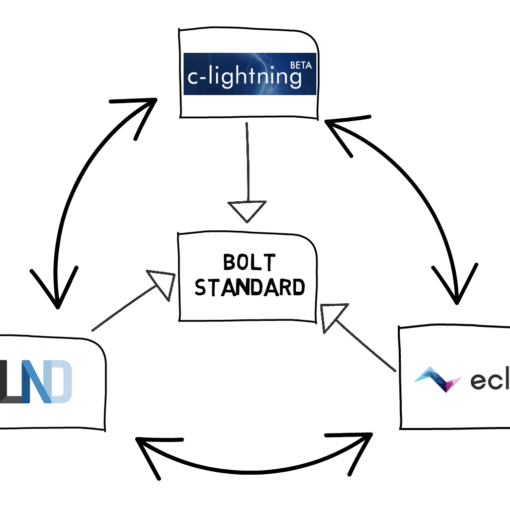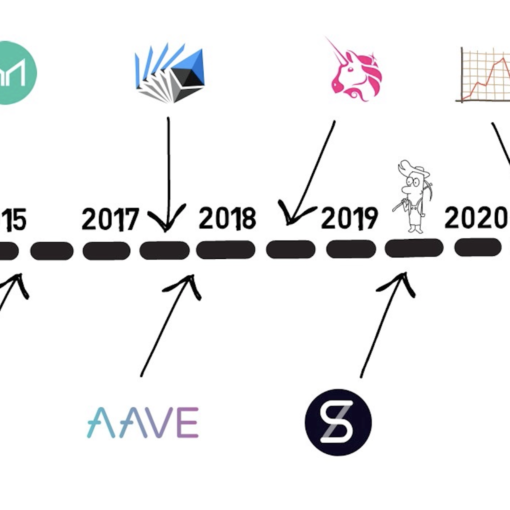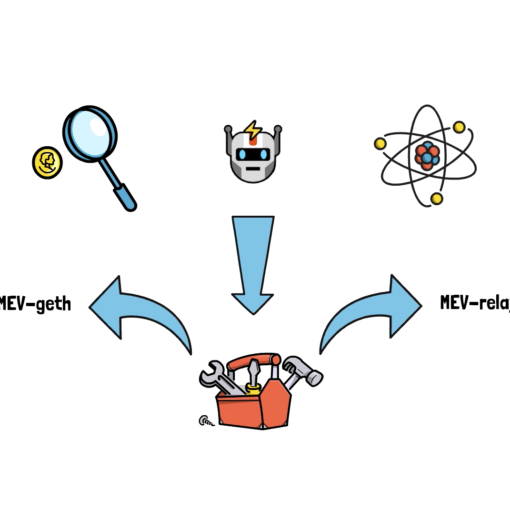So what is Polygon, previously Matic, all about? How will it help with scaling Ethereum? Why does it claim to be Ethereum’s Internet of Blockchains? And why is it sometimes compared to Polkadot and Cosmos? You’ll find answers to these questions in this article.
Now, let’s see how Polygon came into existence.
Matic Network
Before the rebranding to Polygon, the project was known as Matic or Matic Network.
Matic was started in 2017 by 3 founders who were active participants in the cryptocurrency community in India and decided to band together and tackle Ethereum’s scaling problems.
The team worked on 2 main solutions:
Plasma Chains – a layer 2 scaling solution based on Matic’s implementation of Plasma and a PoS Chain – a Proof-Of-Stake Ethereum sidechain.
The token behind Matic Network – MATIC – was distributed through the Binance Launchpad’s initial exchange offering in April 2019 and the team was able to raise $5.6M.
After over 2.5 years of work, The Matic Network Mainnet went live in mid-2020 and quickly started attracting more and more attention. This was supercharged by the increasing gas fees on Ethereum that showed an urgent need for finding robust scaling solutions.
Polygon Rebranding
At the beginning of 2021, the Matic team decided to expand the scope of their project and rebranded themselves to Polygon.

Polygon aims at creating a more generalised scaling solution.
When it comes to scaling there are 2 main ways of doing it: Layer 2 scaling and sidechains.
Layer 2 scaling relies on the security of the main layer – the Ethereum blockchain. Plasma, Optimistic rollups and ZK rollups are the most popular options.
Sidechains rely on their own security models, usually by having a separate consensus mechanism. Matic PoS chain or xDai are good examples here.
If you’re interested in learning more about these different scaling solutions you can check out this article here.
Instead of providing one or two scaling solutions, Polygon aims at creating an ecosystem that makes it easy to connect multiple different scaling solutions – everything from sidechains with different consensus mechanisms to Layer 2 options such as Plasma, Optimistic Rollups and ZK rollups.
We can think about the existing Matic scaling solutions – the PoS and the Plasma chains basically becoming one of many scaling options available in the whole Polygon ecosystem.
Polygon also provides a framework that makes it easy for new projects to quickly build their own highly-customisable scaling solution if they decide this is the path they want to choose.
Now, let’s have a closer look at the technology behind Polygon to understand the project a bit better.
Polygon Architecture
Polygon supports two major types of Ethereum-compatible blockchain networks: stand-alone networks and secured chains – networks that leverage a “security as a service” model.
Stand-alone chains rely on their own security, for example, they can have their own consensus models such as Proof-Of-Stake or Delegated-Proof-Of-Stake. These kind of networks are fully sovereign which presents them with the highest level of independence and flexibility, but it makes it more difficult for them to establish a reliable security model. For example, PoS requires a high number of reliable validators. This kind of model is usually suitable for enterprise blockchains and already established projects with strong communities.
Secured chains utilise the “security as a service” model. This can be either provided directly by Ethereum, for example via fraud proofs used by Plasma, or by a pool of professional validators. These validators are run in the Polygon ecosystem and they can be shared by multiple projects – a concept similar to Polkadot’s shared security model. Secured chains offer the highest level of security but sacrifice independence and flexibility. This model is usually preferred by startups and security-focused projects.
As we’ve probably noticed, the distinction between stand-alone chains and secured chains is even more generic than the usual split between sidechains and layer 2 solutions that we described earlier. This allows Polygon to accommodate pretty much all possible scaling solutions.
Now, as we know what kind of solutions are supported by Polygon, let’s dive a bit deeper into the architecture.
Polygon architecture consists of 4 abstract and composable layers.
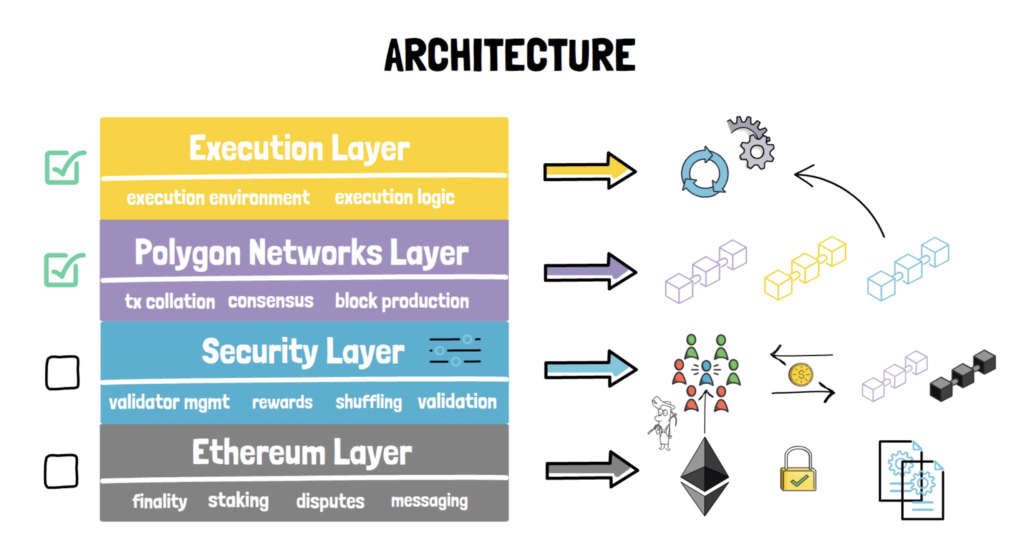
The Ethereum Layer. Polygon chains can use Ethereum as their base layer and leverage Ethereum’s high security. This layer is implemented as a set of smart contracts on Ethereum and can be used for things like finality and checkpointing, staking, dispute resolution and messaging between Ethereum and Polygon chains.
This layer is optional as Polygon-based chains are not obligated to use it.
The next one is the Security Layer. This is another non-mandatory layer that can provide a “validators as a service” function. This function allows Polygon chains to make use of a set of validators that can periodically check the validity of any Polygon chain in return for a fee.
This layer is usually implemented as a meta blockchain that runs in parallel to Ethereum and is responsible for things like validator management – registering/deregistering, rewards, shuffling and Polygon Chains validation.
The Security Layer is fully abstract and can have multiple implementations with different characteristics. This layer can also be implemented directly on Ethereum and leverage Ethereum’s miners as validators.
The next layer is the Polygon Networks Layer. This is the first mandatory layer in the Polygon architecture. This layer consists of sovereign blockchain networks where each network can maintain the following functions: transaction collation, local consensus and block production.
Last, but not least is the Execution Layer. This layer is responsible for interpreting and executing transactions that are included in Polygon’s chains. It consists of the execution environment and execution logic sublayers.
The main takeaway when it comes to Polygon’s architecture is that it is deliberately made to be generic and abstract. This allows other applications, that are looking to scale, to choose the best scaling solution that perfectly fits their needs.
As we know, different applications may want to optimise for different things such as security, transaction speed, transaction cost or sovereignty and to excel in one of them usually means making a sacrifice somewhere else.
As an example, a DeFi protocol that aims at storing billions of dollars locked in smart contracts probably wants to optimise for security and might be happy with sacrificing sovereignty. A protocol like this would most likely use the Ethereum Layer.
Another project, let’s say an NFT marketplace, may want to optimise for ultra-low transaction costs and would be ok with making a sacrifice by lowering their security from extremely high to high enough. Such a project could skip the Ethereum Layer and rely on the Security Layer, with a set of shared validators.
Or maybe a blockchain-based game wants to rely on its own consensus mechanism with ultra-fast block time. In this case, they can entirely skip both the Ethereum and the Security Layer and focus on the Polygon Network Layer.
As we can see, Polygon can provide multiple options and the teams behind different applications can decide to pick the one that perfectly fits their use cases. It also aims at making it easy to migrate from one scaling solution to another one. This might be needed if the circumstances behind a project change, or if another better scaling solution becomes available.
This architecture also allows for multiple different Polygon-based scaling solutions to communicate with each other. This is super important, as it prevents creating siloed systems.
At the moment, the only scaling solutions available in the Polygon ecosystem are the Matic PoS chain and the Matic Plasma Chain solutions. The team is also actively working on adding multiple other options such as ZK rollups, optimistic rollups, enterprise chains and other side chains.
Currently, projects launching on Polygon start with the Matic PoS and the Matic Plasma Chains.
Matic PoS Chain And Matic Plasma Chains
Matic Plasma Chains is an Ethereum Layer 2, predicate-based Plasma implementation. Plasma, in essence, is a framework for building scalable decentralized applications.
Plasma allows for offloading transactions from the main chain into child chains which enables fast and cheap transactions. One of the drawbacks of Plasma is a long waiting period for users who want to withdraw their funds from Layer 2. Plasma cannot be used to scale general-purpose smart contracts.
Matic PoS Chain is a permissionless sidechain and runs in parallel to the Ethereum chain. The chain is secured by the Proof-Of-Stake consensus mechanism with its own validators.
Although Matic PoS Chain has its own consensus mechanism it also relies on Ethereum’s security when it comes to validator staking and checkpoints.
Matic PoS chain is EVM-compatible, which allows Ethereum-based projects to effortlessly migrate their smart contracts.
So far, Matic PoS Chain and Matic Plasma Chains were able to onboard over 80 applications, process over 5M transactions and secure over $200M of users’ funds.
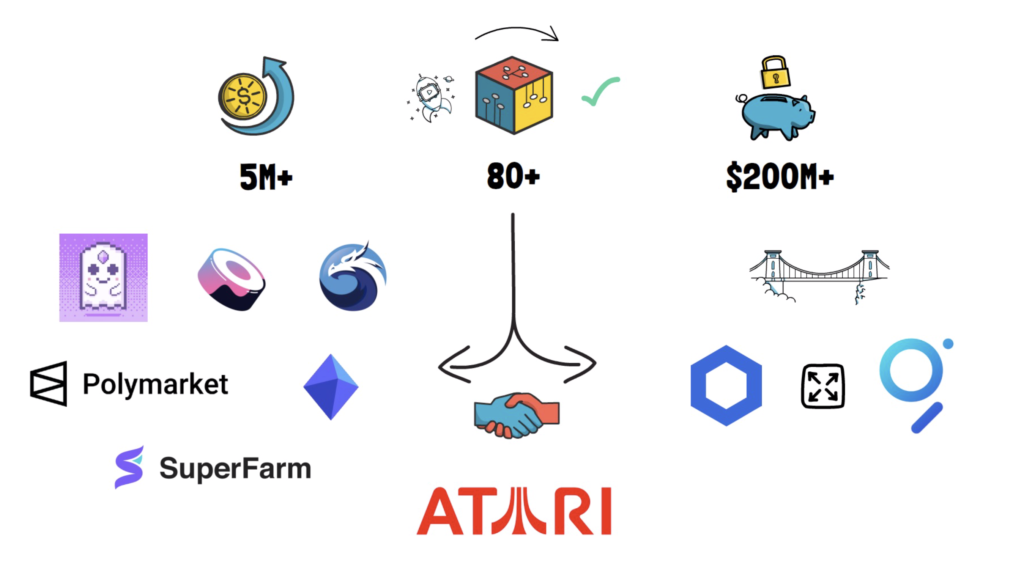
Some of the projects that have either already migrated to Matic PoS Chain, launched directly on Matic, or are in the process of migrating include Quickswap – a fork of Uniswap, Sushiswap, Aavegotchi, Polymarket, Polkamarkets and Superfarm.
Besides that, infrastructure projects such as The Graph and Chainlink also decided to expand to Polygon.
Recently, Polygon also announced a partnership with a big player in the video gaming industry – Atari.
Summary
So far, it looks like Matic’s rebranding to Polygon and the expansion of the scope of the project was a really good idea.
This is mainly because it becomes clearer and clearer that there will be a spectrum of different scaling solutions available in the future.
In the new architecture, Polygon can facilitate connections between these different scaling options.
It also looks like there is a big focus on both optimistic rollups and ZK rollups which Polygon can also add to the multitude of available scaling solutions.
The main risk here would be if one of these popular scaling technologies gets adopted on its own without integrating with Polygon. But even if this happens, there is a chance that this technology would eventually be integrated into Polygon anyway.
It will be interesting to track Polygon’s progress when it comes to adding more scaling options and onboarding more and more projects.
We’ll also have to see how easy it will be to communicate between different scaling solutions with different security guarantees.
It’s also worth mentioning that Polygon’s whitepaper has direct comparisons to other layer 1 blockchains such as Polkadot, Cosmos or Avalanche that also focus on the interoperability between different blockchains.

In contrast to these projects, Polygon focuses on the Ethereum ecosystem, with the Ethereum chain being the main hub that connects everything.
This, of course, has a lot of advantages such as a strong community of users and developers, a well-known programming language – Solidity – and the most popular virtual machine in the cryptocurrency space – EVM.
Besides that, Ethereum has a long history of serving as a reliable base chain that handles trillions of dollars in economic activities. Something that took time to develop and is hard to be replicated by a completely new blockchain.
The power of familiarity with the Ethereum stack cannot be overlooked as shown by the recent rise of Binance Smart Chain.
So what do you think about Polygon? Will this be the ultimate way of scaling Ethereum?
If you enjoyed reading this article you can also check out Finematics on Youtube and Twitter.
Finematics is also now participating in Round 9 of Gitcoin Grants based on the quadratic funding mechanism where even the smallest contribution matters. If you’d like to show your extra support, check out this link here.

